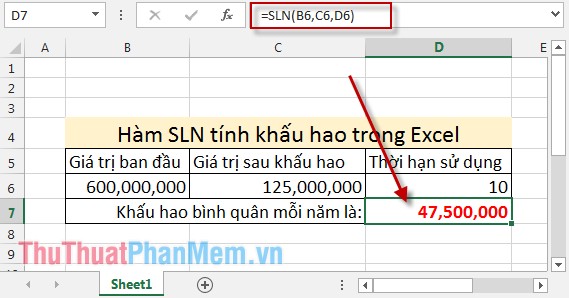SLN function - Returns the depreciation value of an asset using the straight-line method in Excel
The following article details the syntax and usage of SLN in excel.
Description: Returns the depreciation of assets according to the straight-line method over a given period.
Syntax: SLN (cost, salvage, life) .
Inside:
- cost : The initial cost of the property, is a required parameter.
- salvage : Value after depreciation, also called the value of product recall, is a mandatory parameter.
- life : Number of periods of depreciation, also known as useful life of assets, is a required parameter.
Attention:
- SLN function is calculated by the formula:

For example: Calculating the annual average depreciation for an asset with initial value of 600,000,000 and the remaining value after depreciation is 125,000,000 and the asset has a shelf life of 10 years.

In the cell to calculate enter the formula: = SLN (B7, C7, D7) .

Press Enter -> the average depreciation per year of the property over a 10 year period is:

The above is a detailed guide of usage and specific example of SLN function. Hope to help you in the case of depreciation calculation.
Good luck!
You should read it
- DDB function - Calculate depreciation of assets in Excel
- AMORDEGRC function - The function returns the depreciation for each accounting period in Excel
- LINEST function - The function returns a line description array using the least square method in Excel
- DB function - The function calculates the depreciation of assets with specific maturity in Excel
- SLOPE function - The function returns the slope of a linear regression line through data points in Excel
- INTERCEPT function - The function returns the point at which the line will intersect the y-axis by using the existing x and y values in Excel
 DDB function - Calculate depreciation of assets in Excel
DDB function - Calculate depreciation of assets in Excel MINVERSE function - The function returns the inverse matrix of a given matrix in Excel
MINVERSE function - The function returns the inverse matrix of a given matrix in Excel CHIDIST function - Function returns the right end probability of the distribution when squared in Excel
CHIDIST function - Function returns the right end probability of the distribution when squared in Excel COUPNCD - The function returns the next coupon date in Excel
COUPNCD - The function returns the next coupon date in Excel COUPPCD - The function returns the previous coupon date before the settlement date in Excel
COUPPCD - The function returns the previous coupon date before the settlement date in Excel CUMPRINC function - The function calculates the cumulative capital amount payable in Excel
CUMPRINC function - The function calculates the cumulative capital amount payable in Excel